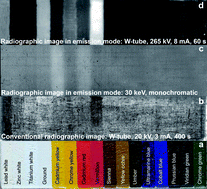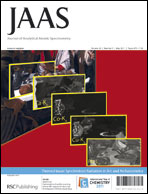Improved radiographic methods for the investigation of paintings using laboratory and synchrotron X-ray sources†
Abstract
It is generally known that radiographic inspection of 15–17th century paintings can easily be done with a polychromatic X-ray source using a voltage between 20 kV and 40 kV in combination with classic X-ray films. Unfortunately, the spatial structure of numerous 19th and early 20th century paintings cannot be visualized with conventional radiography due to several reasons such as the use of lead white grounds or low absorbing pigments. Radiographic images are blurred or worse, they do not contain the picture of the painting. During the last decades, many technological innovations have been introduced in the field of radiography but their possibilities in cultural heritage have not been explored in full detail. In our investigation we used phosphor imaging plates, energy dispersive detectors and CCD-cameras in combination with synchrotron radiation and conventional X-ray tubes in order to improve the quality of radiographic images. Several promising techniques that could improve the quality of radiographs of paintings were identified.

- This article is part of the themed collection: Synchrotron Radiation in Art and Archaeology

 Please wait while we load your content...
Please wait while we load your content...